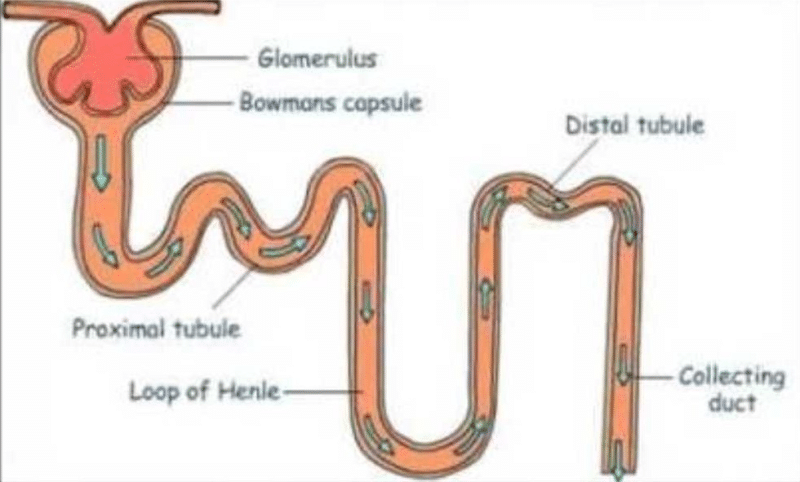Class 10 Exam > Class 10 Questions > Explain the structures of nephron?
Start Learning for Free
Explain the structures of nephron?
Most Upvoted Answer
Explain the structures of nephron?
The nephron is the functional unit of the kidney responsible for the filtration, reabsorption, and secretion of various substances. It consists of two main parts: the renal corpuscle and the renal tubule.
Renal Corpuscle:
The renal corpuscle is the initial part of the nephron and is composed of the glomerulus and Bowman's capsule. It is responsible for filtering blood and producing urine.
- Glomerulus: A network of tiny blood vessels that filters blood and removes waste products.
- Bowman's capsule: A cup-shaped structure that surrounds the glomerulus and collects the filtered blood.
Renal Tubule:
The renal tubule is a long, coiled tube that extends from Bowman's capsule and is responsible for reabsorption and secretion.
- Proximal convoluted tubule: The first part of the renal tubule where most of the reabsorption of water, glucose, amino acids, and ions takes place.
- Loop of Henle: A U-shaped section of the renal tubule that concentrates urine by reabsorbing water and ions.
- Distal convoluted tubule: The final part of the renal tubule where selective reabsorption and secretion of ions and drugs occur.
- Collecting duct: A series of tubules that collect urine from several nephrons and transport it to the renal pelvis.
Overall, the nephron plays a crucial role in maintaining the body's fluid and electrolyte balance by regulating the amount of water and solutes that are excreted in the urine.
Renal Corpuscle:
The renal corpuscle is the initial part of the nephron and is composed of the glomerulus and Bowman's capsule. It is responsible for filtering blood and producing urine.
- Glomerulus: A network of tiny blood vessels that filters blood and removes waste products.
- Bowman's capsule: A cup-shaped structure that surrounds the glomerulus and collects the filtered blood.
Renal Tubule:
The renal tubule is a long, coiled tube that extends from Bowman's capsule and is responsible for reabsorption and secretion.
- Proximal convoluted tubule: The first part of the renal tubule where most of the reabsorption of water, glucose, amino acids, and ions takes place.
- Loop of Henle: A U-shaped section of the renal tubule that concentrates urine by reabsorbing water and ions.
- Distal convoluted tubule: The final part of the renal tubule where selective reabsorption and secretion of ions and drugs occur.
- Collecting duct: A series of tubules that collect urine from several nephrons and transport it to the renal pelvis.
Overall, the nephron plays a crucial role in maintaining the body's fluid and electrolyte balance by regulating the amount of water and solutes that are excreted in the urine.
Community Answer
Explain the structures of nephron?


|
Explore Courses for Class 10 exam
|

|
Question Description
Explain the structures of nephron? for Class 10 2025 is part of Class 10 preparation. The Question and answers have been prepared according to the Class 10 exam syllabus. Information about Explain the structures of nephron? covers all topics & solutions for Class 10 2025 Exam. Find important definitions, questions, meanings, examples, exercises and tests below for Explain the structures of nephron?.
Explain the structures of nephron? for Class 10 2025 is part of Class 10 preparation. The Question and answers have been prepared according to the Class 10 exam syllabus. Information about Explain the structures of nephron? covers all topics & solutions for Class 10 2025 Exam. Find important definitions, questions, meanings, examples, exercises and tests below for Explain the structures of nephron?.
Solutions for Explain the structures of nephron? in English & in Hindi are available as part of our courses for Class 10.
Download more important topics, notes, lectures and mock test series for Class 10 Exam by signing up for free.
Here you can find the meaning of Explain the structures of nephron? defined & explained in the simplest way possible. Besides giving the explanation of
Explain the structures of nephron?, a detailed solution for Explain the structures of nephron? has been provided alongside types of Explain the structures of nephron? theory, EduRev gives you an
ample number of questions to practice Explain the structures of nephron? tests, examples and also practice Class 10 tests.

|
Explore Courses for Class 10 exam
|

|
Signup for Free!
Signup to see your scores go up within 7 days! Learn & Practice with 1000+ FREE Notes, Videos & Tests.
























